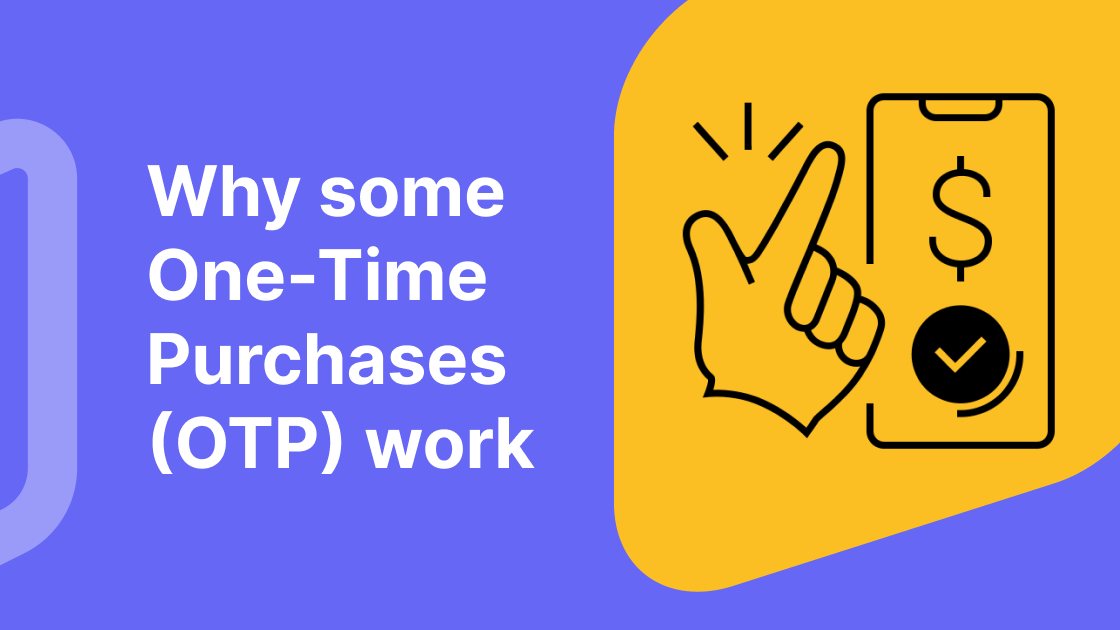In part two of our series about one-time purchases, learn why some one-time purchases are still a viable pricing strategy to consider for certain industries and products.
It's no secret that subscriptions have been on the rise in recent years. But as more and more companies jump on the subscription bandwagon, it's important to remember that one-time purchases can still be an effective revenue model.
In this article, we'll take a closer look at why one-time purchases can still work for a variety of industries, including Software, e-commerce, and mobile games. We'll also be looking at some real-world examples of companies that have successfully implemented one-time purchase models.
Remind me, what is a one-time purchase model?
A one-time purchase model is a pricing strategy in which the customer pays a single upfront cost to buy a product or service. After the initial purchase, there are no further payments required. This is in contrast to a recurring subscription revenue model, where the customer pays a regular recurring fee (e.g. monthly or annually) to continue using a product or service.
An example of a one-time purchase model would be purchasing a video game for a console. Once the game is purchased, the customer can continue to play it without any additional costs. On the other hand, a music streaming service like Spotify operates on a recurring subscription revenue model, where customers pay a monthly fee to access the service.
Why do one-time purchases work?
As the example above demonstrates, one-time purchases are still a viable pricing strategy for many businesses and products. While the shift towards subscription models provide many benefits - including reliable revenue, reduced churn and better customer retention - there are lots of reasons why a customer might still prefer a one-time payment:
-
Ownership. One-time purchases can be a more attractive option for customers who want to fully own a product, rather than rent it.
-
Greater sense of value. A one-time purchase can provide a sense of value for a customer, as they may feel like they are getting more for their money.
-
More suitable. One-time purchases may also be more suitable for certain types of products, such as physical goods where a subscription is not necessary.
Types of one-time purchases
There are lots of examples of industries and a one-time payment pricing strategy is better suited to the types of products that the industry offers. Let’s take a look at some of those industries.
Software as a Product (SaaP)
SaaP refers to software that is sold as a product, meaning customers purchase a license to use the software and have the option to install and run it on their own servers or computers. This software often requires a one-time purchase or payment for a perpetual license and may include additional costs for support and upgrades.
Compare this to the software-as-a-service, or SaaS model, which refers to software delivered via the internet and accessed on a subscription basis. The software is hosted and maintained by the provider, and customers access it via a web browser. Customers typically pay a recurring fee, such as a monthly or annual subscription. An example of SaaS would be a cloud-based project management tool like Asana or Trello.
So, the main difference between SaaP and SaaS is the way that the software is delivered and the way that the customer pays for it. SaaP is generally a one-time purchase, while SaaS is typically subscription-based. Some examples of SaaP products include:
-
TurboCAD (a CAD design software for architects and engineers that enables users to perform 3D modelling).
-
CorelDRAW (a vector illustration software that is used by graphic designers, marketers, and illustrators).
-
Finale (a music notation software used to create sheet music and compose music).
-
Ableton Live (a digital audio workstation (DAW) software to create, produce and perform music).
E-commerce
E-commerce is simply internet shopping. Subscription e-commerce, on the other hand, allows customers to subscribe to their website or app for recurring delivery of products or services. Think Amazon Prime, Hello Fresh, Dollar Shave Club. However, while the global subscription e-commerce market is expected to continue growing at a rapid pace - with a compound annual growth rate of 68% from 2022-2027, according to IMARC Group - that doesn’t mean one-time purchases are going out fashion completely.
Think about the last pair of trainers you bought. The last TV. Or the last set of golf clubs. These types of products don’t require memberships because there isn’t a recurring need. In the US, for example, the majority of shoppers tend to buy sports apparel like trainers every six months. TVs should last up to 10 years or more.
There are lots of examples of brands that still use a one-time payment strategy:
-
Etsy
-
Walmart
-
Home
-
Nike
-
Adidas
-
Zara
-
ASOS
Mobile games
The most popular pricing strategies currently for mobile games are In-App Purchases (IAP) and freemium. In-App Purchases allow players to purchase virtual items, such as in-game currency or additional levels, within the game. Freemium games are free to download and play, but offer additional in-game content or bonuses for a price.
However, the one-time payment method can still work, where users can purchase a game outright and have access to all its content without the need for additional In-App Purchases (although many mobile games choose to use a combination of both pricing strategies - see our article on App Pricing Models for more on this).
There are several iOS and Android games that use a one-time payment strategy. For example, Minecraft, Monument Valley, and Terraria are all iOS and Android games that are available for purchase at a one-time payment. These games are not dependent on In-App Purchases for players to enjoy the full experience. However the catch may be that this model works better for well-known game developers or popular games.
Other mobile games that use a one-time payment strategy include:
*Minecraft, This War of Mine and Monopoly combine a paid pricing model (where users pay upfront for the game) with In-App Purchases. For more on app pricing strategies, check out our article).
What are the business benefits of a one-time payment strategy?
So we’ve talked about the benefits of this pricing strategy for consumers - what about for businesses and app developers?
One of the major advantages of this is that it gives companies the opportunity to bring in increased revenue at the outset by charging the full value for what they are offering. This implies that, instead of relying on funds trickling in over time as they do with a subscription model, companies can reinvest this capital in different parts of the business without delay.
Another benefit is that companies or developers that use a one-time payment method don’t have to worry about losing subscribers. That’s not to say a company operating with this strategy doesn’t need to demonstrate its product’s value, build trust and loyalty with users in order to keep them coming back and buying again. However, this may be a challenge for small organizations with limited resources and other more pressing business priorities.
Key takeaways
-
One-time purchase models still work for customers who want to fully own a product or want to feel like they’re getting better value for money.
-
Small businesses with limited budgets may find advantages in this approach, as it allows them to avoid expending resources on managing and maintaining subscribers.
-
For certain product or service types, such as buying trainers, a TV, or hiring a plumber, making a single purchase for a product or service may be the most suitable option.
-
Many leading mobile games, most notably Minecraft, are finding success with a combination of one-time payments and In-App Purchases.
Increase In-App Purchases with Purchasely
You can probably guess that we’re Team Subscription all the way! Yes, there are some benefits of adopting a one-time payment pricing strategy. But in the world of mobile apps, subscriptions are increasingly becoming the way forward. Consider this: the average smartphone owner uses 10 apps per day and 30 apps each month. That’s a staggering amount and is only set to increase as the subscription economy continues to grow.
Purchasely is a monetization platform for apps that provide one-time purchases and In-App Subscriptions. We can help you increase one-time buyers and subscribers and build a sustainable, predictable revenue model. With our Paywall Builder, you can design and A/B tests native screens with one-time purchase or subscribe call-to-actions. Furthermore, you can display a one-time purchase offer to a specific user cohort and a subscription offer to another user cohort.
Want a product walkthrough? Book a Purchasely demo and see how you can grow revenue by increasing your In-App Purchases today.
Or you can check out our latest newsletter issue with the inspiration Purchasely Paywall Gallery and some subscription optimization best practices.




